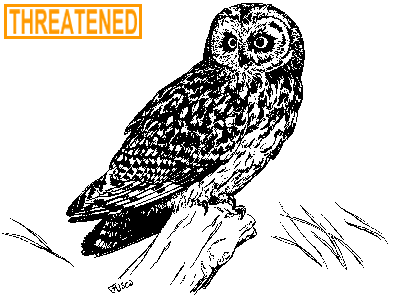Short-eared Owl
Asio flammeus

Habitat: Open country, such as grasslands, marshes or meadows.
Weight: Females, 13.4 ounces; males, 11.1 ounces.
Length: 13-17 inches.
Wingspan: 38-44 inches.
Life Expectancy: Short-eared owls have lived more than 12 years in the wild.
Food: Mice, voles, shrews, rabbits, bats, grasshoppers, beetles, cutworms and small birds, such as field sparrows.
Status: State threatened (wintering populations).
Identification: The short-eared owl is tawny, with bold streaks on the breast, and a pale, lightly streaked belly. Its ear tufts are barely visible. In flight, the long wings show a buffy patch above and a black wrist mark below. The short-eared owl appears big-headed and neckless in its buoyant, moth-like flight. Its voice can be compared to the nasal bark of a dog, "wak, wak."
Range: The short-eared owl is found on every continent except Australia. Its population is declining throughout most of its range.
Reproduction: The breeding season for the short-eared owl usually begins in late April. The shallow, unlined nest is built on the ground and sheltered by tall grass, reeds or bushes. The 4 to 8 eggs are short, oval, smooth and non-glossy. They are laid at 2-day intervals. The female incubates the eggs, beginning with the first egg, for 24 to 28 days. After hatching, the female tends the young while the male brings food. The young owls leave the nest 12 to 17 days after hatching, but they do not fly until 10 days later.
Reason for Decline: The loss of inland marshes, meadows and coastal wetlands to human development has contributed to the decline of this species.
History in Connecticut: There are accounts of short-eared owls nesting in Connecticut in the 1800s. This species bred north of Hartford in the Connecticut River Valley before the 1860s and was considered a resident. Presently, Connecticut has no confirmed breeding populations of short-eared owls. The small wintering population is considered threatened.
Interesting Facts: Although short-eared owls mainly hunt at dawn and dusk, they are also observed hunting during the daytime. When hunting for prey, the owls circle and glide close to the ground. These birds usually roost on low perches or on the ground.
During courtship, male short-eared owls will fly high over the nest, calling, flapping, soaring and occasionally swooping while clapping the wings below the body.
While caring for its young, a short-eared owl will perform an "injured bird" act to lead away intruders.
Short-eared owls are somewhat nomadic, often moving to areas with high rodent populations to settle and breed.
Protective Legislation: Federal - Migratory Bird Treaty Act of 1918. State - Connecticut General Statutes Sec. 26-311.
What You Can Do: Learn more about owls by consulting references at your local library. Enjoy owls from a distance. Most importantly, encourage the protection of large, open, grassy areas (at least 24-105 acres) for use as foraging (hunting) and nesting sites by short-eared owls.

The production of this Endangered and Threatened Species Fact Sheet
Series is made possible by donations to the Endangered Species/Wildlife Income Tax
Checkoff Fund.
(rev. 12/99)

